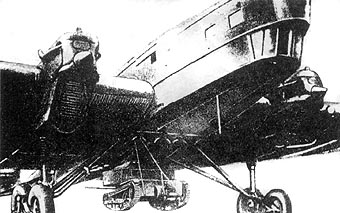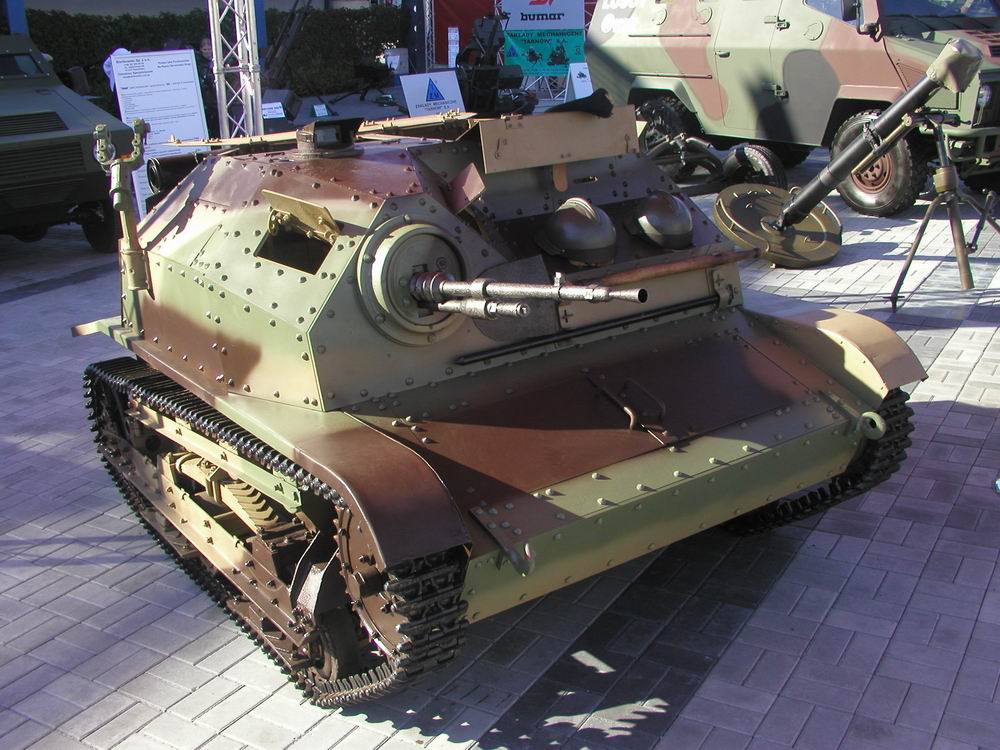|
T-37A
The T-37A was a Soviet amphibious light tank. The tank is often referred to as the T-37, although that designation was used by a different tank which never left the prototype stage. The T-37A was the first series of mass-produced fully amphibious tanks in the world. The tank was first created in 1932, based on the British Vickers tankette and other operational amphibious tanks. The tank was mass-produced starting in 1933 up until 1936, when it was replaced with the more modern T-38, based on the T-37A. Overall, after four years of production, 2552 T-37As were produced, including the original prototypes. In the Red Army, they were used to perform tasks in communication, reconnaissance, and as defense units on the march, as well as active infantry support on the battlefield. The T-37A was used in large numbers during the Soviet invasion of Poland and in the Winter War against Finland. T-37As were also used by the Soviets in the beginning of the Great Patriotic War, but m ... [...More Info...] [...Related Items...] OR: [Wikipedia] [Google] [Baidu] |
T-38 Tank
The T-38 amphibious scout tank was a Soviet amphibious light tank that saw service in World War II. Developed as a modernized version of the earlier T-37A light tank, the T-38 proved to be only a moderate improvement over its predecessor, and was eventually replaced in 1940 by the T-40. History Early trials of the T-37A revealed many deficiencies in its design, including limited range, sub-par buoyancy, and an unreliable transmission and running gear that could cause its tracks to fall off while on the move.Baryatinskiy, p. 15-19 Development of an improved version of the tank that would fix these flaws was begun in late 1934 at Factory No. 37 in Moscow, under the direction of Chief Designer N. Astrov and Chief Engineer N. Kozyrev.Zaloga, p. 77-79 The redesign proved to be so extensive that the project was given the independent designation T-38, and a prototype was completed by June 1935. The T-38 retained many design features of the T-37A, including its repurposed GAZ-AA en ... [...More Info...] [...Related Items...] OR: [Wikipedia] [Google] [Baidu] |
Amphibious Vehicle
An amphibious vehicle (or simply amphibian), is a vehicle that is a means of transport viable on land as well as on or under water. Amphibious vehicles include amphibious bicycles, ATVs, cars, buses, trucks, railway vehicles, combat vehicles and hovercraft. Classic landing craft are not amphibious vehicles as they do not offer any real land transportation at all, although they are part of amphibious warfare. Ground effect vehicles, such as ''ekranoplans'', will likely crash on any but the flattest of landmasses so are also not considered to be amphibious vehicles. General technical notes Apart from the distinction in sizes mentioned above, two main categories of amphibious vehicles are immediately apparent: those that travel on an air-cushion ( Hovercraft) and those that do not. Amongst the latter, many designs were prompted by the desire to expand the off-road capabilities of land-vehicles to an "all-terrain" ability, in some cases not only focused on creating a tr ... [...More Info...] [...Related Items...] OR: [Wikipedia] [Google] [Baidu] |
T-27
The T-27 was a tankette produced in the 1930s by the Soviet Union. It was based on the design of the Carden Loyd tankette, bought under license from the United Kingdom in 1930. Design The Soviets were not fully satisfied with the Carden Loyd design and made a number of changes before putting it into mass production under the designation of T-27. Compared with the British original, the hull was larger, the running gear was improved and the weapon mount was modified to take a Soviet 7.62 mm DT machine gun. A number of other changes were made by Chief Engineer N. Kozyrev and Lead Engineer K. Sirken to improve the tankette's ability to cope with the Russian climate and terrain. It lacked any communication devices, as communication between vehicles was intended to be carried out using signal flags. Service The tankette was accepted into service on February 13, 1931. It was manufactured in two factories simultaneously, the Bolshevik factory in Leningrad and what would later become ... [...More Info...] [...Related Items...] OR: [Wikipedia] [Google] [Baidu] |
Tankette
A tankette is a tracked armoured fighting vehicle that resembles a small tank, roughly the size of a car. It is mainly intended for light infantry support and scouting.T-27 Tankette (from the 'battlefield.ru' website, with further references cited. Accessed 2008-02-21.) Colloquially it may also simply mean a small tank. Several countries built tankettes between the 1920s and 1940s, and some saw limited combat in the early phases of . The vulnerability of their light armour, however, eventually led armies to abandon the concept with some exceptions such as the more modern German Wiesel (Weasel) series. ...
|
Kubinka Tank Museum
The Kubinka Tank Museum (Центральный музей бронетанкового вооружения и техники - Tsentral'nyy Muzey Bronetankovogo Vooruzheniya I Tekhniki -Central Museum of Armored Arms and Technology) is a large military museum in Kubinka, Odintsovsky District, Moscow Oblast, Russia where tanks, armoured fighting vehicles (AFVs) and their relevant information are displayed and showcased. The museum consists of open-air and indoor permanent exhibitions of many famous tanks and armored vehicles from throughout the 20th and 21st centuries (between 1917 and the present day). It also houses and displays many unique, unusual and one-of-a-kind military vehicles of which there are very few remaining examples, such as the German Panzer VIII Maus super-heavy tank, Troyanov's Object 279 Kotin heavy tank, the Karl-Gerät heavy self-propelled artillery, and the Object 120 Su-152 "Taran" tank destroyer, amongst other single or limited-production prototypes f ... [...More Info...] [...Related Items...] OR: [Wikipedia] [Google] [Baidu] |
GAZ-AA
The GAZ-AA was a truck produced at the Gorki Auto Plant from 1932 to 1938, as the company's first truck produced under the ''GAZ'' brand name. History In 1929 the Soviet Union made an agreement with the Ford Motor Company to produce the Ford Model A and Model AA vehicles at an automotive plant built in Nijni Novgorod. Initially, 10 Ford Model AA trucks were built at the plant, under the ''NAZ'' name (Nijni Novgorod Automobilni Zavod). Soviet engineers prepared their own mechanical blueprints for production, for the truck to be made by more thick steel and to have an upgraded suspension system. During the following years, the plant was renamed to ''Gorki Automobilni Zavod'' after Maxim Gorki, leading the index of the trucks to be changed to ''GAZ-AA''. By 1932, the GAZ-AA started to get mass-produced and by that time around 60 trucks were built at the plant daily from knock-down kits sent by Ford. Soon the assembly of the GAZ-A passenger vehicles started, that were based on ... [...More Info...] [...Related Items...] OR: [Wikipedia] [Google] [Baidu] |
T-33 Tank
The Lockheed T-33 Shooting Star (or T-Bird) is an American subsonic jet trainer. It was produced by Lockheed and made its first flight in 1948. The T-33 was developed from the Lockheed P-80/F-80 starting as TP-80C/TF-80C in development, then designated T-33A. It was used by the U.S. Navy initially as TO-2, then TV-2, and after 1962, T-33B. The last operator of the T-33, the Bolivian Air Force, retired the type in July 2017, after 44 years of service. Design and development The T-33 was developed from the Lockheed P-80/F-80 by lengthening the fuselage by slightly more than 3 feet (1 m) and adding a second seat, instrumentation, and flight controls. It was initially designated as a variant of the P-80/F-80, the TP-80C/TF-80C. Design work on the Lockheed P-80 began in 1943, with the first flight on 8 January 1944. Following on the Bell P-59, the P-80 became the first jet fighter to enter full squadron service in the United States Army Air Forces. As more advanced jet ... [...More Info...] [...Related Items...] OR: [Wikipedia] [Google] [Baidu] |
Tractor
A tractor is an engineering vehicle specifically designed to deliver a high tractive effort (or torque) at slow speeds, for the purposes of hauling a trailer or machinery such as that used in agriculture, mining or construction. Most commonly, the term is used to describe a farm vehicle that provides the power and traction to mechanize agricultural tasks, especially (and originally) tillage, and now many more. Agricultural implements may be towed behind or mounted on the tractor, and the tractor may also provide a source of power if the implement is mechanised. Etymology The word ''tractor'' was taken from Latin, being the agent noun of ''trahere'' "to pull". The first recorded use of the word meaning "an engine or vehicle for pulling wagons or plows" occurred in 1896, from the earlier term " traction motor" (1859). National variations In the UK, Ireland, Australia, India, Spain, Argentina, Slovenia, Serbia, Croatia, the Netherlands, and Germany, the word "tractor" u ... [...More Info...] [...Related Items...] OR: [Wikipedia] [Google] [Baidu] |
All Russian Co-Operative Society
The All-Russian Co-operative Society (Arcos) was the principal body responsible for orchestrating Anglo-Soviet trade in the early days of the Soviet Union, following the development of Vladimir Lenin's New Economic Policy. Its headquarters was located in Hampstead, London. In 1927 the organisation was raided by British authorities, who accused the company as serving as a front for subversive activities. Origins The All-Russian Co-operative Society, Ltd., began operations in London in October 1920. The name "Arcos" is an acronym deriving from the formal name of the company: All-Russian Co-operative Society, although in the contemporary press the name was typically capitalised as would be a proper name (i.e. "ARCOS"). Arcos was established as the official buying and selling agency of the Soviet government in the United Kingdom,"The Work of Arcos", p. 19. and was a British company, operating under British law, although the stockholders were all Soviet citizens. Arcos made £1,97 ... [...More Info...] [...Related Items...] OR: [Wikipedia] [Google] [Baidu] |
Leningrad
Saint Petersburg ( rus, links=no, Санкт-Петербург, a=Ru-Sankt Peterburg Leningrad Petrograd Piter.ogg, r=Sankt-Peterburg, p=ˈsankt pʲɪtʲɪrˈburk), formerly known as Petrograd (1914–1924) and later Leningrad (1924–1991), is the second-largest city in Russia. It is situated on the Neva River, at the head of the Gulf of Finland on the Baltic Sea, with a population of roughly 5.4 million residents. Saint Petersburg is the fourth-most populous city in Europe after Istanbul, Moscow and London, the most populous city on the Baltic Sea, and the world's northernmost city of more than 1 million residents. As Russia's Imperial capital, and a historically strategic port, it is governed as a federal city. The city was founded by Tsar Peter the Great on 27 May 1703 on the site of a captured Swedish fortress, and was named after apostle Saint Peter. In Russia, Saint Petersburg is historically and culturally associated with ... [...More Info...] [...Related Items...] OR: [Wikipedia] [Google] [Baidu] |





